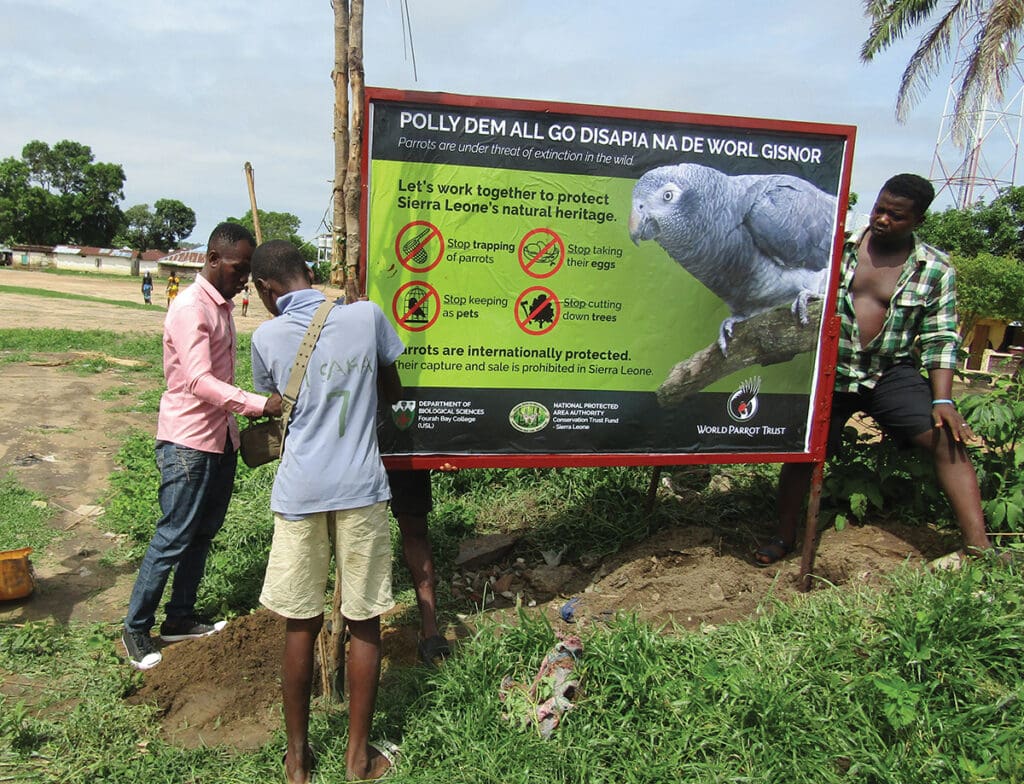Timneh Parrots: Local Conservation and Awareness
Status:

Collaborators/Funders:
IBAP (National Institute for Biodiversity and Protected Areas), the Coastal Planning Cabinet of Guinea-Bissau, Dr. Paulo Catry (ISPA – Instituto Universitário, Portugal), Dr. Davide De Guz, The Wara Conservation Project (SALF and GALF programmes), Save Our Species (SOS), ZooMarine Portugal, Whitley Wildlife Conservation Trust, Bridging Peace Foundation, Folke H Peterson Trust, MAVA, Explore Trees, CENFOR
The conservation of Timneh Parrots (Psittacus timneh) depends on the collaboration and engagement of communities that live near them. The WPT has led or supported several projects.
In the Bijagós, UNESCO Biosphere Reserve community-based initiatives have employed former poachers to guard nests. 2018 research in Sierra Leone also uncovered a small but possibly significant local trade in parrots as pets. Timneh Parrots were found for sale in a market stall in Freetown and several bird owners were identified. One of the study’s authors has spread awareness of Timnehs’ plight to parrot sellers and the general community. There has also been a connection with communities to discuss local people’s attitudes and experiences with the birds to create a better understanding by both sides. In addition, ‘parrot champions’ have been identified, and a WhatsApp group now connects them to share information on the parrots.
A co-management plan for this area, agreed upon by all 12 Chiefdoms and funded by USAID, has recently been developed, with the project findings leading to multiple actions to protect Timneh Parrots. To reach the public country-wide the team launched a sensitisation campaign.
Supported by the WPT-Natural Encounters Conservation Fund, a team from the University of Liberia and U.S. Forest Service International Programs set out to understand the relationship between local villagers and a roosting population of Timneh Parrots in a remote village in southeastern Liberia. Over a year, the team conducted field surveys and engaged with the local community to understand how this sizable roosting population has survived and what the future may hold. The study unveiled a close interaction between people and parrots, with both sides protecting and benefiting from each other.
CENFOR, a Liberia-based organisation dedicated to promoting conservation, management and sustainable use of the country’s biodiversity, is working with the Forestry Development Authority and the Ministries of Justice and Education on a project, supported by the WPT and Natural Encounters, to bring attention to Timneh Parrots in Grebo-Krahn National Park (GKNP) in southeastern Liberia. Their activities include organising awareness campaigns in two communities, establishing school wildlife clubs, and distributing and analysing questionnaires to uncover threats against and abundance of the Timneh Parrot.
Status: IUCN Endangered / CITES Appendix I
Population: Likely fewer than 100,000, decreasing.
Range: Native to the western parts of the moist Upper Guinea forests and bordering savannas of West Africa extending from the Bijagós islands of Guinea-Bissau eastwards through southern Guinea, Sierra Leone, Liberia and Côte d’Ivoire.
Natural history: This species is found in primary and secondary rainforest, forest edges and clearings, gallery forest, mangroves and savanna. Its diet consists of seeds, nuts, fruits (including oil palm) and berries. Will sometimes travel great distances for food. Are generally seen in small, but vocal, flocks of a few dozen. Breeding is during the dry season; January-February, and June-July. Its nest is in a high, live tree in a hollow.
